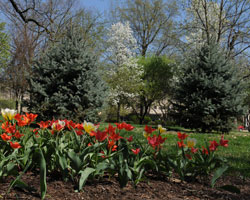Helpful tips for managing the home landscape
Information to help your lawn and garden look its best, including the creatures to watch out for.
 Photo and caption available
Photo and caption available
Released: May 9, 2016
MANHATTAN, Kan. – As we get deeper into spring, our attention will likely turn to making our lawns and gardens look their best. Anyone who has done yard work probably knows that a well-manicured, green lawn is not going to happen by itself. Luckily, Raymond Cloyd, professor of entomology at Kansas State University, has helpful tips for properly managing home lawns and gardens, particularly when it comes to controlling insects and other lawn-dwelling creatures.
Cloyd said one of the biggest dangers lurking for landscapers are eastern tent caterpillars, which are common throughout Kansas.
“One of our earliest caterpillar defoliators we encounter is the eastern tent caterpillar,” said Cloyd, a pest management specialist with K-State Research and Extension. “Although it is still a bit early, we should be aware. As soon as anything in the Rosaceae family – such as crabapple trees – starts to leaf, you will see nests at the crotch of the trees. What is in these nests are the larvae of these caterpillars.”
When the caterpillars begin feeding, he said, it causes stress to the plant that can negatively affect its appearance and overall health. The caterpillars are active during the day and return to the nest at night; therefore, they should be removed quickly – during the night preferably – to minimize possible damage.
Cloyd recommends knocking nests off the tree and breaking them up with either a stick or a rake, which would allow birds to easily eat the larvae. There aren’t preventative measures to control the eastern tent caterpillars, only reactive measures.
In addition to the crabapple, other trees in the Rosaceae family that could be impacted by eastern tent caterpillars include plum and pear trees.
Unlike eastern tent caterpillars, bees are a positive insect to have living around lawns and gardens, but currently, honeybees, bumblebees and other native bees are under a lot of stress due to habitat loss, lack of diversity, farming systems and pesticides, Cloyd said.
He stressed the importance of preventing pesticide drift on plants that are visited by bees.
“One of the most toxic materials is Sevin, which is a broad-spectrum insecticide,” the entomologist said. “If you are going to use Sevin, make sure to avoid using it where bees are due to it being extremely toxic to that order of insects (Hymenoptera).”
It is best to not spray when the bees are active – above 55 degrees Fahrenheit for honeybees and 40 F for bumblebees, he said, adding that it’s also important to not spray plants in bloom, which attract bees. In addition, try not to spray on a windy day to minimize the possibility of unintentional drift. Spraying early in the morning will minimize the possibility of direct contact with the bees, as they are not active at that time.
“It is important to keep these things in mind, because without the bee we are going to have a restricted diet,” Cloyd said. “Many crops are almost completely pollinated by bees.”
A less talked about aspect of insect control, he said, is proper sanitation throughout the growing season. Many insect species, such as the squash bug, will winter in various debris and weeds. These insects often bore into the ground. By removing debris in the lawn or garden from last year, people can reduce the likelihood that these bugs will become a problem in the spring and summer.
K-State Research and Extension Entomology has a newsletter that runs into November, which provides timely information on common garden and field crop pests. It is available online at Department of Entomology Newsletter.
More information is also available at local extension offices throughout Kansas or through K-State Research and Extension’s Master Gardeners, who are trained to answer lawn and garden questions.
-30-
K-State Research and Extension is a short name for the Kansas State University Agricultural Experiment Station and Cooperative Extension Service, a program designed to generate and distribute useful knowledge for the well-being of Kansans. Supported by county, state, federal and private funds, the program has county Extension offices, experiment fields, area Extension offices and regional research centers statewide. Its headquarters is on the K-State campus, Manhattan.
Story by:
Connor Orrock
K-State Research and Extension
cworrock@ksu.edu
For more information:
Raymond Cloyd, rcloyd@ksu.edu or 785-532-4750
